VLAN Trunking Protocol VTP Tutorial
This topic describes the features that VLAN Trunking Protocol (VTP) offers to support VLANs. To help you understand the basic concept, this is a summary of what VTP is:
“VTP allows a network manager to configure a switch so that it will propagate VLAN configurations to other switches in the network”
VTP minimizes misconfigurations and configuration inconsistencies that can cause problems, such as duplicate VLAN names or incorrect VLAN-type specifications. VTP helps you simplify management of the VLAN database across multiple switches.
VTP is a Cisco-proprietary protocol and is available on most of the Cisco switches.
Why we need VTP?
To answer this question, let’s discuss a real and popular network topology.
Suppose you are working in a medium company in a 5-floor office. You assigned each floor to a switch for easy management and of course they can be assigned to different VLANs. For example, your bosses can sit in any floor and still access Manage VLAN (VLAN 7). Your technical colleagues can sit anywhere on the floors to access Technical VLAN (VLAN 4). This is the best design because each person’s permission is not limited by the physical location.
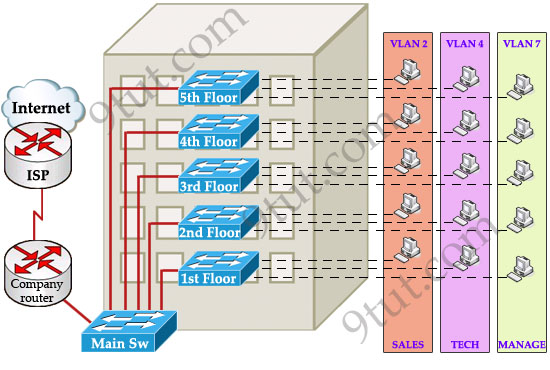
Now let’s discuss about VTP role in this topology! Suppose VTP is not running on these switches. One day, your boss decides to add a new department to your office, the Support Department, and you are tasked to add a new SUPPORT VLAN for this department. How will you do that? Well, without VTP you have to go to each switch to enable this new VLAN. Fortunately your office only has 5 floors so you can finish this task in some hours :)
But just imagine if your company was bigger with 100-floor office and some VLANs needed to be added every month! Well, it will surely become a daunting task to add a new VLAN like this. Luckily, Cisco always “thinks big” to create a method for you to just sit at the “Main Sw”, adding your new VLANs and magically, other switches automatically learn about this VLAN, sweet, right? It is not a dream, it is what VTP does for you!
How VTP Works
To make switches exchange their VLAN information with each other, they need to be configured in the same VTP domain. Only switches belonging to the same domain share their VLAN information. When a change is made to the VLAN database, it is propagated to all switches via VTP advertisements.
To maintain domain consistency, only one switch should be allowed to create (or delete, modify) new VLAN. This switch is like the “master” of the whole VTP domain and it is operated in Server mode. This is also the default mode.
Other switches are only allowed to receive and forward updates from the “server” switch. They are operated in Client mode.
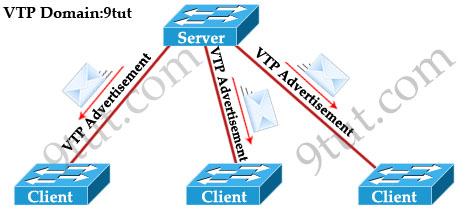
In some cases, the network manager doesn’t want a switch to learn VTP information from other switches. He can set it to Transparent mode. In this mode, a switch maintains its own VLAN database and never learn VTP information from other switches (even the server). However, it still forwards VTP advertisements from the server to other switches (but doesn’t read that update). A transparent switch can add, delete and modify VLAN database locally.
Now return to the example above, we can configure any switches as the “server” but for our convenience, the “Main Sw” should be assigned this function and we should place it in a safe place.
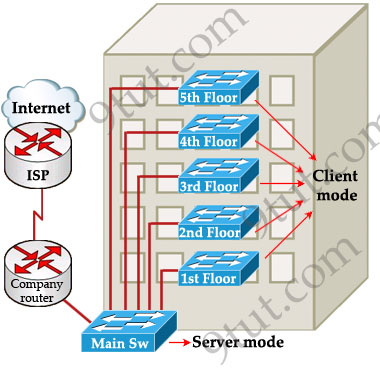
As said above, VTP advertisements bring VLAN information to all the switches in a VTP domain. Each VTP advertisement is sent with a Revision number. This number is used in order to determine whether the VTP advertisement is more recent than the current version of that switch. Because each time you make a VLAN change in a switch, the configuration revision is incremented by one. So the higher the revision number, the better your VTP advertisement.
For example, the first time the Main Sw sends a VTP advertisement, its Revision number is 1. When you add a new VLAN to the Main Sw, it will send a VTP advertisement with the Revision number of 2. Client switches first receive the VTP advertisement with the Revision number of 1, which is bigger than its current Revision number (0) so it updates its VLAN database. Next it receives the VTP advertisement with the Revision number of 2, it continues comparing with its current Revision number (1) -> it continues update its VLAN database.
One important thing you must know is when a switch receives a better VTP advertisement, it deletes its whole VTP information and copy the new information from the better VTP advertisement to its VLAN database. A switch does not try to compare its own VLAN database with information from the received VTP advertisements to find out and update the difference!
Note: VTP advertisements are sent as multicast frames and all neighbors in that domain receive the frames.
The “show vtp status” command analysis
The most important command to view the status of VTP on Cisco switches that each CCNA learners must grasp is the “show vtp status” command. Let’s have a look at the output of this command:

+ VTP Version: displays the VTP version the switch is running. By default, the switch runs version 1 but can be set to version 2. Within a domain, the two VTP versions are not interoperable so make sure to configure the same VTP version on every switch in a domain.
+ Configuration Revision: current Revision number on this switch.
+ Maximum VLANs Supported Locally: maximum number of VLANs supported locally.
+ Number of Existing VLANs: Number of existing VLANs.
+ VTP Operating Mode: can be server, client, or transparent.
+ VTP Domain Name: name that identifies the administrative domain for the switch.
By default, a switch operates in VTP Server mode with a NULL (blank) domain name with no password configured (the password field is not listed in the output)
+ VTP Pruning Mode: displays whether pruning is enabled or disabled. We will discuss about VTP Pruning later.
+ VTP V2 Mode: displays if VTP version 2 mode is enabled. VTP version 2 is disabled by default.
+ VTP Traps Generation: displays whether VTP traps are sent to a network management station.
+ MD5 Digest: a 16-byte checksum of the VTP configuration.
+ Configuration Last Modified: date and time of the last configuration modification. Displays the IP address of the switch that caused the configuration change to the database.
VTP Pruning
To understand what VTP Pruning is, let’s see an example:
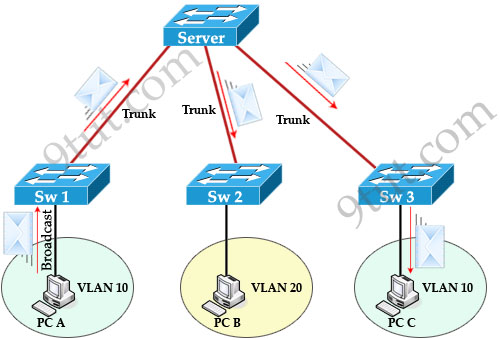
When PC A sends a broadcast frame on VLAN 10, it travels across all trunk links in the VTP domain. Switches Server, Sw2, and Sw3 all receive broadcast frames from PC A. But only Sw3 has user on VLAN 10 and it is a waste of bandwidth on Sw2. Moreover, that broadcast traffic also consumes processor time on Sw2. The link between switches Server and Sw2 does not carry any VLAN 10 traffic so it can be “pruned”.
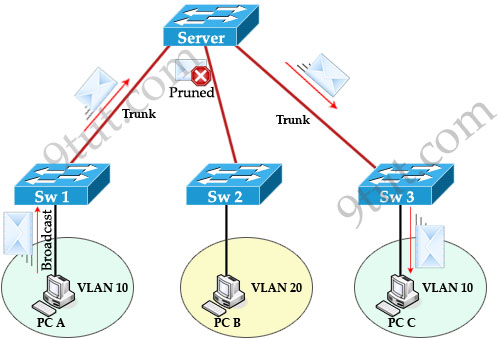
VTP Pruning makes more efficient use of trunk bandwidth by forwarding broadcast and unknown unicast frames on a VLAN only if the switch on the receiving end of the trunk has ports in that VLAN. In the above example, Server switch doesn’t send broadcast frame to Sw2 because Sw2 doesn’t have ports in VLAN 10.
When a switch has a port associated with a VLAN, the switch sends an advertisement to its neighbors to inform that it has active ports on that VLAN. For example, Sw3 sends an advertisement to Server switch to inform that it has active port for VLAN 10. Sw2 has not advertised about VLAN 10 so Server switch will prune VLAN 10 on the trunk to Sw2.
You only need to enable pruning on one VTP server switch in the domain.
VTP Configuration
Main Sw(config)#vtp version 2
Main Sw(config)#vtp domain 9tut
Main Sw(config)#vtp mode server
Main Sw(config)#vtp password keepitsecret
On client switches
Client(config)#vtp version 2
Client(config)#vtp domain 9tut
Client(config)#vtp password keepitsecret
Client(config)#vtp mode client
Notice: Before configuring VTP make sure the links between your switches are trunk links. Your trunk link can automatically be formed if both of your switches are not 2960 or 3560 because ports on the 2960 and 3560 switches are set to dynamic auto by default. If both sides are set to dynamic auto, the link will remain in access mode. To configure trunk between these ports, use these commands:
Client(config)#interface fa0/1 (or the interface on the link you want to be trunk)
Client(config-if)#switchport mode trunk
These commands only need to be used on one of two switches to form the trunk.
Below summaries important notes about VTP:
+ Whenever a change occurs in the VLAN database, the VTP server increments its configuration revision number and then advertises the new revision throughout the VTP domain via VTP advertisements.
+ VTP operates in one of three modes: server, transparent, or client.
VTP modes:
* Server: The default mode. When you make a change to the VLAN configuration on a VTP server, the change is propagated to all switches in the VTP domain. VTP messages are transmitted out of all the trunk connections. In Server mode we can create, modify, delete VLANs.
* Client: cannot make changes to the VLAN configuration when in this mode; however, a VTP client can send any VLANs currently listed in its database to other VTP switches. VTP client also forwards VTP advertisements (but cannot create VTP advertisements).
* Transparent: When you make a change to the VLAN configuration in this mode, the change affects only the local switch and does not propagate to other switches in the VTP domain. VTP transparent mode does forward VTP advertisements that it receives within the domain.
VTP Pruning makes more efficient use of trunk bandwidth by forwarding broadcast and unknown unicast frames on a VLAN only if the switch on the receiving end of the trunk has ports in that VLAN.
For more information about VTP, I highly recommend you to visit the official tutorial about VTP published by Cisco. It is very comprehensive: http://www.cisco.com/warp/public/473/vtp_flash/



Thank you for explaining something that is very difficult to understand, very simply.
Hello,
In the VTP Pruning part, it’s written that “You only need to enable pruning on one VTP server switch in the domain”, but there is no special VTP pruning config below.
Does it mean that VTP version 2 enables VTP pruning by default ?
Other switches are only allowed to receive and forward updates from the “server” switch. They are operated in Client mode.
Is it suppose to be like this, in client mode it can forward and receives VTP advertisement, whereas it cannot create. Correct me if im wrong.
Thanks,
Hari
this is super,, thx
i just wanna say .its cool and simple to understand…….thnks buddy
i am going for my exam in a month time, so what should i remeber for the exam?
is it true that you have to fail the exam first for you to pass it?
nice stuff ………
If a switch in transparent mode donesnt read any upadate then what is the need of a switch in this mode?
@amin jan
maybe you don’t want a particular switch to have the same vlans as all the others
thanks a lot
pls can someone send me the latest dumps plss… abdulbm911@gmail.com
Its really nice stuff, easy to understand…thumbs up 9tut. Great Job!!!!
what are 2 command that can be used to see if there is a vlan mismatch ?
this was one of the questions on the icnd 2 exam
is it vtp stat ?
Tanks a lot !!!it help me ,,,great job ..love 9tut
its very easy to understand . very good.
It is very easy to understand the concept. Keep it up.
@9tut
Kindly explain this point
does vtp client sync its local vlan database with other switches or is able to create vlans locally or just learns the updates advertised by the server sw
secondly
does vtp enables to share complete vlan databases? it means the syncronize the ports assignment per vlan as well?
Thanks
@9tut
how would we solve the problem if we have two server mode switches in a domain and we have a greater revision number of the newly connected switch.
revision number is used for the synchronization purpose.the switch having greater revision number overwrites its database to other switches.how do we maintain the correct synchronization process
thanks
@bilal
“Client: cannot make changes to the VLAN configuration when in this mode; however, a VTP client can send any VLANs currently listed in its database to other VTP switches. VTP client also forwards VTP advertisements (but cannot create VTP advertisements).”
vtp client will update the database of other switches in client/server mode. they must match vtp version, password, domain. the updater must have a greater revision number.
Thanks @xallax
It means a switch in “client” mode being in VTP can not even update its own local vlan database.
@bilal
no, it can not modify on its own its VLAN database, but it can update it if an update frame is received and it can originate update frames
yow nine tut u a di boss!!! mi a go shell dung di exam tomorrow so mi will mek unoo know how it go seen
Good explanation listed. :-)
@9tut:
I have a question? I know we can rename the existing VTP Domain to a new one and it will propagate to other client switches in the same VTP Domain… My question is can we totally remove the VTP Domain name, like make it blank or like a new no configuration switch.. Because im trying to remove it but it cannot…
thanks alot 9tut…
@AGP
make sure all vtp-capable interfaces are disabled or unplugged or configured in vtp access so there’s no risk to get the vtp domain name through frame from neighboring switches
go to privileged mode and type:
delete vlan.dat
confirm the deletion, type:
reload
confirm that you wish to reboot the device and wait for it to start up.
after it loaded go to privileged mode and type:
show vtp status
there should be nothing set as the domain name
cheers
@xallax:
by the way, i already figured it out and we have the same process… but what i did in deleting vlan database is…
switch#del flash:vlan.dat
and it also works…and the vlan id & vlan name also removed as long as the switchports are not yet assigned to a vlan…but once the switchports are assigned to a vlan it will not be removed just by deleting the vlan database…have to delete also the startup config to remove them…
thanks alot…you’re the man…
Thanks a lot… very is easy and effective explanation… :) :)
pliz send me da latest sim for all….my mail id is robinmoirang417@gmail.com….
thanks
9TUT your tutorial is so comprehensive and easy to understand. thanks a lot continue your mindblowing thinking to do so
Can anyone answer this question please?
what are 2 command that can be used to see if there is a vlan mismatch ?
Thanks,
PLEASE I WANT SOME EXAMPLES ON SPANNING TREE PROTOCOL..
Show vlan brief
@WASIM MOHAMMED: For STP please read here: http://www.9tut.com/spanning-tree-protocol-stp-tutorial
very nice
thank,s for this pratical. 9TUT
@ethiolon
1 command that you can use is show log, normally when there is a vlan mismatch the switch logs will be flooded by vlan mismatch message..
@xallax
only a vtp server can be the origin of a vtp advertisement. so client cant originate a VTP adevertisement it can only forward advertisement that comes from the vtp server
@jopy
uhm… nope.
try this out in packettracer: add 2 switches to the topology.
set them to be vtp clients
connect them using a crossover cable.
set the domain name on one of them to ABC.
check the vtp status on the other switch. it will be… ABC.
very informative…..
thanks
Thank u so much
thank you very much 9tut…………..
nice
KEEP GOING ON SUCCESS
Good…it is from hands to mouth.. thanks a lot.
Thank you!
I have not sen any response to Nishant’s question above. I have the same concern. 9tut, do you have any input on this? Thanks.
@Nishant, @Klauss: Yes, it may be a security hole. But in fact we have many ways to secure this prolem like RootGuard, BPDU Filtering. You will learn them in SWITCH (a module of CCNP).